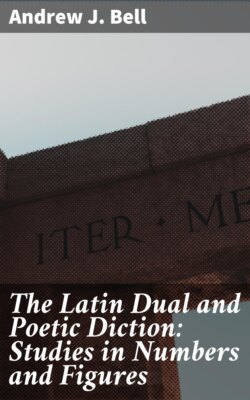Читать книгу The Latin Dual and Poetic Diction: Studies in Numbers and Figures - Andrew J. Bell - Страница 10
На сайте Литреса книга снята с продажи.
V
THE NUMBERS IN GREEK AND LATIN,
AND THEIR RELATIONS
ОглавлениеTable of Contents
Numbers are three, Dionysius Thrax tells us, Singular (ἑνικός), Dual (δυϊκός), Plural (πληθυντικός). But there are singular expressions used also for many, e.g. δῆμος, χορός, ὄχλος; and plurals used both for singulars and duals; for singulars, e.g. Ἀθῆναι, Θῆβαι; and for duals, e.g. ἀμφότεροι (p.30, Uhlig). Such is the statement about numbers in our oldest grammar; but it is far from being full or exhaustive. Let us state the matter a little more fully and in detail.
(1) The singular is used for the plural. Dionysius’s examples are all nouns of multitude, where no one would dream of counting the units, or treating them as individuals, e.g. ψάμμος or ψάμαθος ‘sand’. Here the Greek usually has either the singular or the plural with the same meaning; e.g. λαός or λαοί; while Latin uses the singular populus. In English we use now the singular, now the plural, saying ‘wheat’ and ‘barley’, but ‘oats’ and ‘pease’. When Virgil ventured in imitation of ἄλφιτα to write hordea ‘barleys’, he met with Bavius’s reproach:
Hordea qui dixit, restat ut tritica dicat,
a reproach fully justified by Latin idiom.
(2) The plural is used for the singular. Dionysius’s examples for Greek are names of cities, like Athens or Thebes, and Latin gives us similar examples in Veii, Gabii, Corioli. The same is true of festivals held on a single day like Θεσμοφόρια, Διονύσια, Ἐλευσίνια, Saturnalia, Kalendae, Idus.
(3) The plural is used for the dual; indeed Homer uses the plural δοιοί instead of δύω (Il. 5. 206), and in the first Iliad Achilles greets the two heralds: χαίρετε, κήρυκες (v.334). After Aristotle the dual passes out of use in Greek, and for a pair the plural is regularly used. In Latin duo and ambo are the only two duals recognized by the Romans, and for the remaining cases of these words plural forms are used, like ambos or duobus. Speaking generally, when the dual goes out of use the plural takes its place.
(4) The dual is used for the plural. In Greek for several pairs we often find the dual used, and not the plural, as in: οἱ δ’ ἅμα πάντες ἐφ’ ἵπποιϊν μάστιγας ἄειραν (Il. 23. 362) ‘and they all with one accord raised their whips upon their teams’. Dionysius does not proceed to give us this use, probably from a natural piety. Zenodotus, the founder of the Alexandrian school of grammarians, maintained that Homer used the dual for the plural; but Aristarchus of Samothrace, the teacher of Dionysius, wrote in refutation of this a treatise now lost. No doubt he tried to show that in all examples of this use cited by Zenodotus there was an idea of pairing involved that justified the use of the dual. But the syntax of ἁλόντε with γένησθε in:
μήπως, ὡς ἀψῖσι λίνου ἁλόντε πανάγρου
ἀνδράσι δυσμενέεσσιν ἕλωρ καὶ κύρμα γένησθε (Il. 5. 487-8)
seems to involve no such idea of pairing. In Latin while octo and viginti, old duals, are used as plurals, this idea of pairs is primarily involved, though no longer felt. But equae ‘the mares’, primarily a dual (=Skt. açve), is used for any number of mares.
(5) We have examined in the previous chapters a number of cases where in Latin the singular is evidently used for the dual. This use seems rarer in Greek; but where in Skt. we have nāsā ‘the nose’, a duale tantum, in Greek we find ῥίς or ῥῖνες, a singular or a plural.
(6) The dual is used for the singular, but not in Greek or Latin. But in Latin we find plurals used for older duals in use for the singular. In Sanskrit we find two duals used for two related singulars in: Mitrā Varunā. So in: Lugete o Veneres Cupidinesque (Catull. 3.1) we have two plurals used similarly for two related singulars.
I might proceed to ask how far we have reason to believe that the dual number is coeval with the singular and the plural. The dual seems to have existed in all branches of the Indo-Germanic family of languages; and so we have a right to consider it an inflexion of the primitive Indo-Germanic. But probably it was much later and more imperfect in its development than the singular and the plural. The inflexions for the dual of nouns, pronouns, and verbs seem to show from their lack of development that the dual was later, and was never in regular use even for pairs. Its use is most fully developed and most regular in Sanskrit and Gothic, both artificial or book languages as we know them.
